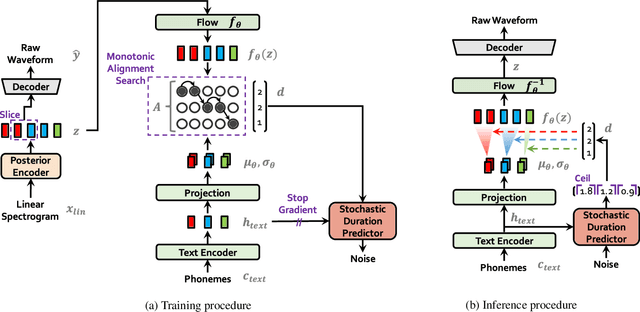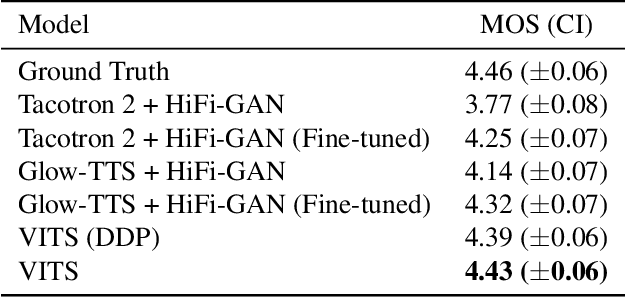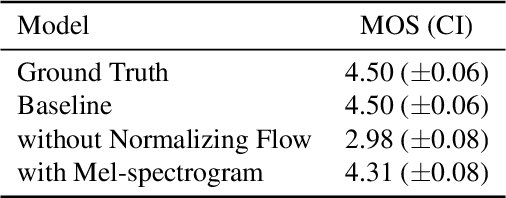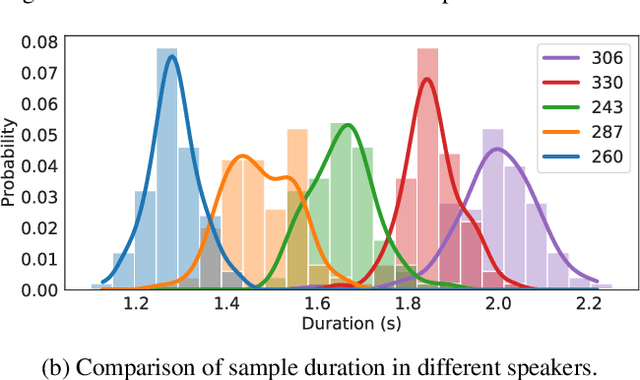Jungil Kong
Encoding Speaker-Specific Latent Speech Feature for Speech Synthesis
Nov 20, 2023Abstract:In this work, we propose a novel method for modeling numerous speakers, which enables expressing the overall characteristics of speakers in detail like a trained multi-speaker model without additional training on the target speaker's dataset. Although various works with similar purposes have been actively studied, their performance has not yet reached that of trained multi-speaker models due to their fundamental limitations. To overcome previous limitations, we propose effective methods for feature learning and representing target speakers' speech characteristics by discretizing the features and conditioning them to a speech synthesis model. Our method obtained a significantly higher similarity mean opinion score (SMOS) in subjective similarity evaluation than seen speakers of a best-performing multi-speaker model, even with unseen speakers. The proposed method also outperforms a zero-shot method by significant margins. Furthermore, our method shows remarkable performance in generating new artificial speakers. In addition, we demonstrate that the encoded latent features are sufficiently informative to reconstruct an original speaker's speech completely. It implies that our method can be used as a general methodology to encode and reconstruct speakers' characteristics in various tasks.
VITS2: Improving Quality and Efficiency of Single-Stage Text-to-Speech with Adversarial Learning and Architecture Design
Jul 31, 2023Abstract:Single-stage text-to-speech models have been actively studied recently, and their results have outperformed two-stage pipeline systems. Although the previous single-stage model has made great progress, there is room for improvement in terms of its intermittent unnaturalness, computational efficiency, and strong dependence on phoneme conversion. In this work, we introduce VITS2, a single-stage text-to-speech model that efficiently synthesizes a more natural speech by improving several aspects of the previous work. We propose improved structures and training mechanisms and present that the proposed methods are effective in improving naturalness, similarity of speech characteristics in a multi-speaker model, and efficiency of training and inference. Furthermore, we demonstrate that the strong dependence on phoneme conversion in previous works can be significantly reduced with our method, which allows a fully end-to-end single-stage approach.
Conditional Variational Autoencoder with Adversarial Learning for End-to-End Text-to-Speech
Jun 11, 2021



Abstract:Several recent end-to-end text-to-speech (TTS) models enabling single-stage training and parallel sampling have been proposed, but their sample quality does not match that of two-stage TTS systems. In this work, we present a parallel end-to-end TTS method that generates more natural sounding audio than current two-stage models. Our method adopts variational inference augmented with normalizing flows and an adversarial training process, which improves the expressive power of generative modeling. We also propose a stochastic duration predictor to synthesize speech with diverse rhythms from input text. With the uncertainty modeling over latent variables and the stochastic duration predictor, our method expresses the natural one-to-many relationship in which a text input can be spoken in multiple ways with different pitches and rhythms. A subjective human evaluation (mean opinion score, or MOS) on the LJ Speech, a single speaker dataset, shows that our method outperforms the best publicly available TTS systems and achieves a MOS comparable to ground truth.
HiFi-GAN: Generative Adversarial Networks for Efficient and High Fidelity Speech Synthesis
Oct 23, 2020



Abstract:Several recent work on speech synthesis have employed generative adversarial networks (GANs) to produce raw waveforms. Although such methods improve the sampling efficiency and memory usage, their sample quality has not yet reached that of autoregressive and flow-based generative models. In this work, we propose HiFi-GAN, which achieves both efficient and high-fidelity speech synthesis. As speech audio consists of sinusoidal signals with various periods, we demonstrate that modeling periodic patterns of an audio is crucial for enhancing sample quality. A subjective human evaluation (mean opinion score, MOS) of a single speaker dataset indicates that our proposed method demonstrates similarity to human quality while generating 22.05 kHz high-fidelity audio 167.9 times faster than real-time on a single V100 GPU. We further show the generality of HiFi-GAN to the mel-spectrogram inversion of unseen speakers and end-to-end speech synthesis. Finally, a small footprint version of HiFi-GAN generates samples 13.4 times faster than real-time on CPU with comparable quality to an autoregressive counterpart.
 Add to Chrome
Add to Chrome Add to Firefox
Add to Firefox Add to Edge
Add to Edge